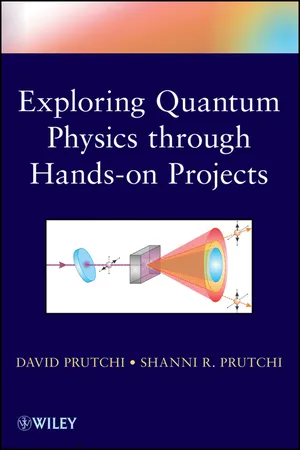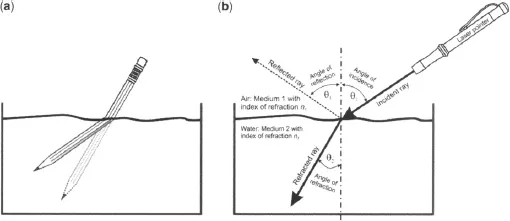![]()
CHAPTER 1
LIGHT AS A WAVE
Before we get into quantum physics, let’s understand the classical view of light. As early as 100 C.E., Ptolemy—a Roman citizen of Egypt—studied the properties of light, including reflection, refraction, and color. His work is considered the foundation of the field of optics. Ptolemy was intrigued by the way that light bends as it passes from air into water. Just drop a pencil into a glass of water and see for yourself!
As shown in Figure 1a, the pencil half under the water looks bent: light from the submerged part of the stick changes direction as it reaches the surface, creating the illusion of the bent stick. This effect is known as refraction, and the angle at which the light bends depends on a property of a material known as its refractive index.
In the 1600s, Dutch mathematician Willebrord Snellius figured out that the degree of refraction depends on the ratio of the two materials’ different refractive indices. Most materials have a refractive index greater than 1, which means that as light enters the material from air, the angle of the ray in the material will become closer to perpendicular to the surface than it was before it entered. This is known as Snell’s Law, which states that the ratio of the sines of the angles of incidence and refraction (θ1, θ 2) is equal to the inverse ratio of the indices of refraction (n1 n2):
Try it out yourself with a small laser pointer! As shown in Figure 1b, partially fill a small aquarium with water. Disperse some milk in the water to make it a bit cloudy, which will make the laser beam visible. Use smoke from a smoldering match or candle to make the laser beam visible in the air above.
Measure the angles between the rays and a line perpendicular to the water surface. The refraction coefficient for water is approximately n2 = 1.333, and for air is more or less n2 = 1. Do your measurements match Snell’s Law?
NEWTON’S VIEW: LIGHT CONSISTS OF PARTICLES
In 1704, Sir Isaac Newton proposed that light consists of little particles of mass. In his view, this could explain reflection, because an elastic, frictionless ball bounces off a smooth surface just like light bounces off a mirror—that is, the angle of incidence equals the angle of reflection.
Remember that Newton was very interested in the way masses attract each other through the force of gravity. In his view, this force was responsible for refraction at the boundary between air and water. Newton imagined that matter is made up of particles of some kind, and that air would have a lower density of these particles than water. This is not far from what we know today—we would call Newton’s particles “molecules” and “atoms.” Newton then proposed that there would be an attractive force, similar to gravity, between the light particles and the matter particles.
Now, when a light particle travels within a medium, such as air or water, it is surrounded on all sides by the same number of matter particles. Newton explained that the attractive forces acting on a light particle would cancel each other out, allowing the light to travel in a straight line. However, near the air–water boundary, the light particle would feel more attracted by water than by air, given the water’s higher density of “matter particles.” Newton proposed that as the light particle moves into the water, it experiences an attractive force toward the water, which increases the light particle’s velocity component in the direction of the water, but not in the direction parallel to the water.
This velocity increase in the direction perpendicular to the air–water boundary would deflect the light closer to perpendicular to the surface, which is exactly what is observed in experiments. Newton thus claimed that the velocity of light particles is different in different transparent materials, believing that light would travel faster in water than in air. (We now know this is not the case, but we’ll get to that in a minute.)
Newton didn’t equate gravity with the attractive force between matter particles and light particles. He needed this force to be equal for all light particles crossing the boundary between two materials to explain how a prism separates white light into the colors of the rainbow. Newton proposed that the mass of a light particle depended on its color. In his view, red light particles would be more massive than violet light particles. Because of their increased inertia, red light particles would thus be deflected less when crossing the boundary between materials.
Newton’s greatness conferred credibility to his theory, but it was not the only one around. Dutch physicist Christiaan Huygens had proposed an earlier, competing theory: light consists of waves. This was supported by the observation that two intersecting beams of light did not bounce off each other as would be expected if they were composed of particles. However, Huygens could not explain color, and the wave versus particle debate for the nature of light raged until decisive experiments were carried out in the nineteenth century.
YOUNG’S INTERFERENCE OF LIGHT
Around 1801, Thomas Young discovered interference of light. This phenomenon is only possible with waves, providing conclusive evidence that light is a wave. In Young’s experiments, light sent through two separate slits results in a pattern that is very similar to the one produced by the interference of water waves shown in Figure 2.
Let’s spend some time experimenting with water waves before we go on to reproducing Young’s experiments on the interference of light. Start by building a ripple tank, as shown in Figure 3, out of a glass baking pan (for example, a Pyrex® rectangular pan), some wood, two rubber bands, and a vibrating motor made for pagers and cellular phones.
The waves in the shallow layer of water are better observed by illuminating them from above to cast shadows through the glass bottom onto a white sheet of paper 50 cm below the tank. Use a spotlight, not a floodlight for illumination. Even better, use a strobe light (like the ones used by party DJs) to “freeze” the waves in place. Fill the pan with water to a depth of around 5 mm, and then fit pieces of metal sponge around the edges of the tank to reduce unwanted wave reflections from the pan’s walls. Test the setup by dimming the room lights and lightly dipping a pencil into the water to create ripples.
To generate continuous plane waves, attach the vibrating motor to a wooden beam. Use rubber bands to suspend the beam from a support beam, and adjust the height of the vibrating beam so that it just touches the water surface. Power the motor from a 1.5-V D cell through a 100 Ω potentiometer (e.g., Clarostat 43C1-100).
Next, set up two straight barriers with a short one between them, along a line parallel to the vibrating beam. Make the gaps between barriers about 1-cm wide. Turn the potentiometer to generate straight waves with a wavelength of about 1 cm. Try different separations between the slits, and see if your data agree with the equation:
where d is the fringe separation (e.g., between the central fringe and the first fringe to its side), λ is wavelength, s is the distance between the slits, and r is the distance from the 2-slit barrier to the point where the fringes are observed.
Thomas Young did essentially the same thing using colored light instead of water waves. We will use inexpensive laser pointers and a simple double slit to replicate the experiment that Young performed to support the theory of the wave nature of light (Figure 4). Instead of making a double-slit slide,* we use one made by Industrial Fiber-optics. Their model IF-508 diffraction mosaic is a low-cost ($6) precision array of double slits and gratings for performing laser double- and multiple-slit diffraction experiments. The mosaic is mounted in a 35-mm slide holder and contains four double slits and three multiple-slit arrays on an opaque background with clear apertures. Double-slit separations range from 45 to 100 μm in width. The gratings are 25, 50, and 100 lines/mm.
Interestingly, Young found that the separation between fringes is related to the distance between the slits exactly through the same equation as ...






